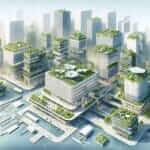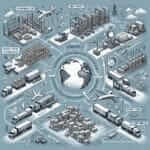The IELTS Reading Test is a critical component of the IELTS exam that assesses a candidate’s ability to understand and interpret written English. With three sections and texts from different sources, candidates must answer 40 questions of various types. One common and increasingly relevant topic is the challenges of maintaining biodiversity in urban areas.
Given the rapid urbanization and its impacts, this theme has appeared in numerous IELTS exams, reflecting its global relevance. Analyzing data trends, we observe that this topic is likely to recur, given its environmental and urban significance.
Reading Passage on Maintaining Biodiversity in Urban Areas
The Passage (Medium Text)
Urban areas are rapidly expanding across the globe. As cities grow, natural habitats are replaced with concrete, glass, and steel structures causing numerous environmental challenges, including the loss of biodiversity. It is critical to address these challenges to ensure sustainable urban living.
Habitat Fragmentation: One of the primary challenges is habitat fragmentation. Urban sprawl leads to the division and isolation of natural habitats, making it difficult for species to migrate and find food, mates, or shelter. Fragmented habitats often lead to decreased genetic diversity and can drive certain species to extinction.
Pollution: Pollution is another significant issue. Air pollution from vehicles and industries, water pollution from urban runoff, and noise pollution stress urban wildlife. Pollutants can alter habitats and directly impact the health of plant and animal species.
Invasive Species: The introduction of invasive species in urban environments disrupts local ecosystems. Non-native plants and animals often outcompete native species for resources, leading to declines in biodiversity.
Human-Wildlife Conflicts: In cities, interactions between humans and wildlife often lead to conflicts. Animals may venture into urban areas in search of food, resulting in negative encounters with humans. This can lead to the culling of wildlife or relocation, further stressing local populations.
Policy and Planning: Effective urban planning and policies are necessary to mitigate these challenges. Green spaces, wildlife corridors, and habitat conservation can help maintain biodiversity. However, the implementation of such measures requires significant investment and political will.
urban-biodiversity|Urban Biodiversity|An image depicting a thriving urban area with integrated green spaces, showcasing a balance between city life and biodiversity.
Questions
Multiple Choice
-
What is one of the primary challenges of maintaining biodiversity in urban areas mentioned in the passage?
a. Climate Change
b. Habitat Fragmentation
c. Overfishing
d. Deforestation -
How does pollution affect urban biodiversity?
a. By providing additional nutrients
b. By altering habitats and impacting species health
c. By promoting the growth of native species
d. By increasing genetic diversity
True/False/Not Given
- The expansion of urban areas globally has no impact on biodiversity. True/False/Not Given
- Invasive species always benefit the local ecosystems in urban areas. True/False/Not Given
Matching Information
Match the information with the correct section of the passage:
- Habitat Fragmentation
- Pollution
- Invasive Species
- Human-Wildlife Conflicts
- Policy and Planning
a. Stresses urban wildlife due to pollutants.
b. Leads to the division of natural habitats.
c. Disrupts local ecosystems with non-native species.
d. Requires political will and investment.
e. Results from animals venturing into cities for food.
Answer Key & Explanations
Multiple Choice Answers:
- (b) Habitat Fragmentation – The passage clearly states that habitat fragmentation is one of the primary challenges.
- (b) By altering habitats and impacting species health – The passage highlights different types of pollution and their effects on biodiversity.
True/False/Not Given Answers:
- False – The passage outlines several impacts of urban expansion on biodiversity.
- False – The passage mentions that invasive species disrupt ecosystems, implying a negative impact.
Matching Information Answers:
a. Pollution – Stresses urban wildlife due to pollutants.
b. Habitat Fragmentation – Leads to the division of natural habitats.
c. Invasive Species – Disrupts local ecosystems with non-native species.
d. Policy and Planning – Requires political will and investment.
e. Human-Wildlife Conflicts – Results from animals venturing into cities for food.
Common Mistakes in Reading Comprehension
One frequent mistake is misinterpreting the information provided. For example, candidates might confuse cause and effect relationships or miss keywords that alter the meaning of a sentence. Another common error is not being able to identify the main idea of a paragraph, which is crucial for answering questions accurately.
Vocabulary and Key Terms
- Habitat Fragmentation (noun) – həˈbɪtæt fræg.mənˈteɪʃən: The process of division and isolation of natural habitats.
- Pollution (noun) – pəˈluː.ʃən: The introduction of harmful substances or products into the environment.
- Invasive Species (noun) – ɪnˈveɪ.sɪv ˈspiː.ʃiːz: Non-native species that disrupt local ecosystems.
- Urban Sprawl (noun) – ˈɜː.bən sprɔːl: The uncontrolled expansion of urban areas.
Grammar Focus
A key grammar point to note is the use of passive voice to describe general environmental impacts. E.g., “Habitats are replaced” or “Biodiversity is affected.” This structure is common in academic writing to focus on the action rather than the subject performing the action.
Advice for High Reading Scores
To achieve a high score in the IELTS reading test, practice regularly with a variety of topics. Focus on enhancing your skimming and scanning skills to quickly locate information. Expand your vocabulary, particularly with academic and topic-specific terms like those related to biodiversity. Lastly, simulate exam conditions to improve your time management skills.
For more in-depth articles on environmental themes linked to urban living, check out our recent piece on The Role of Community Gardens in Urban Areas on IELTS.NET.


